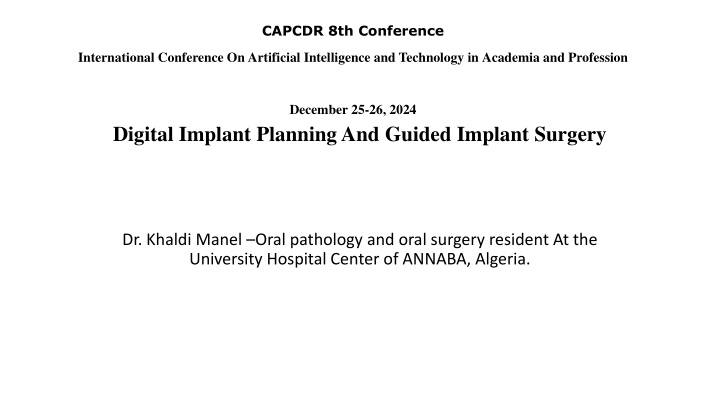
Advanced Techniques in Digital Implant Planning and Guided Surgery
Explore the profound advancements in digital implant planning and guided surgery, revolutionizing dental implantology with enhanced accuracy, safety, and efficiency. Discover key technologies, benefits, challenges, and future perspectives in this cutting-edge field.
Download Presentation

Please find below an Image/Link to download the presentation.
The content on the website is provided AS IS for your information and personal use only. It may not be sold, licensed, or shared on other websites without obtaining consent from the author. If you encounter any issues during the download, it is possible that the publisher has removed the file from their server.
You are allowed to download the files provided on this website for personal or commercial use, subject to the condition that they are used lawfully. All files are the property of their respective owners.
The content on the website is provided AS IS for your information and personal use only. It may not be sold, licensed, or shared on other websites without obtaining consent from the author.
E N D
Presentation Transcript
CAPCDR 8th Conference International ConferenceOnArtificial Intelligence and Technology inAcademia and Profession December 25-26, 2024 Digital Implant Planning And Guided Implant Surgery Dr. Khaldi Manel Oral pathology and oral surgery resident At the University Hospital Center of ANNABA, Algeria.
Plan of the Plan of the Presentation Presentation: : I. II. Key technologies III. Benefits of Digital Implant Planning IV. Guided Implant Surgery V. Challenges VI. Future perspectives VII. Conclusion Introduction and importance
Introduction and importance: Introduction and importance: Digital implant planning and guided implant surgery have significantly advanced the field of dental implantology These techniques leverage modern imaging and design technologies to enhance the accuracy, safety, and efficiency of dental implant placement. Importance: The integration of digital tools allows for better patient outcomes, reduces the risk of complications, and improves communication between the dental team and patients.
Key Technologies: Key Technologies: Cone Beam Computed Tomography (CBCT): Computer-Aided Design and Manufacturing (CAD/CAM): CAD/CAM technology allows for the creation of virtual models of the patient s mouth and dental structures. Using this data, dental professionals can plan implant placements with high precision, designing custom surgical guides to ensure the implants are placed accurately. CBCT is a specialized 3D imaging technique that provides detailed views of the patient s oral and maxillofacial anatomy. It helps clinicians assess bone density, identify anatomical landmarks, and plan precise implant placements. Unlike traditional CT scans, CBCT uses lower radiation doses, making it safer for patients. Fig2,3:Computer-Aided Design and Manufacturing (CAD/CAM): Fig1:CBCT
Benefits of Digital Implant Planning: Benefits of Digital Implant Planning: 1/Accuracy and Precision: Detailed 3D models allow for careful assessment of bone structure, tissue density, and anatomical details, ensuring accurate implant positioning. Planning digitally helps prevent errors that might arise during traditional procedures. 2/Improved Patient Outcomes: The digital approach leads to less invasive surgeries, resulting in reduced trauma, faster healing times, and fewer complications. Enhanced precision ensures that implants are placed exactly where they are needed, improving long- term success rates. 3/Enhanced Patient Communication: Visualizing the treatment plan in 3D helps patients understand the procedure, increasing their confidence and satisfaction. Virtual simulations allow patients to see the potential outcome before surgery, improving informed consent.
Guided Guided Implant Implant Surgery Surgery: : Custom Surgical Guides: After planning the procedure digitally, custom guides are created using CAD/CAM technologies. These guides are used during surgery to ensure that implants are placed in the correct position with precision. Advantages: The use of surgical guides reduces human error during the procedure and ensures accuracy in implant placement. Minimizes the need for adjustments during surgery, leading to quicker and more predictable results. Reduced time in surgery and recovery because of the less invasive nature of the guided procedure. Fig04: surgical guide
Challenges: Challenges: Training and Expertise:The integration of digital technologies into clinical practice requires specialized training. Dentists and surgical teams must learn to effectively use software and equipment, which can require an investment in time and resources. Adaptation to Clinical Workflow: Transitioning from traditional methods to digital implant planning and surgery requires changes to the workflow in dental offices. Clinicians must adapt to new procedures and equipment, which can initially slow down operations and impact efficiency. Cost Considerations: While the technology offers long-term benefits, the initial investment in CBCT, CAD/CAM systems, and surgical guides can be significant.
Future Perspectives Future Perspectives: Advancements in Technology: As technology continues to evolve, the accuracy and functionality of digital implant planning and guided surgery will only improve. Future developments may include even more efficient imaging techniques, AI-powered planning tools, and enhanced integration with other dental technologies. Education and Training: Ongoing education and hands-on training will be crucial for dental professionals to fully utilize the potential of digital implantology. Universities and dental organizations will need to offer continuing education to keep practitioners updated on the latest tools and techniques.
Conclusion: Conclusion: Digital implant planning and guided surgery have significantly transformed implantology by enhancing precision, improving patient outcomes, and reducing surgical risks. Although challenges exist, the benefits far outweigh the obstacles, particularly with the increasing availability of affordable and accessible technology.
